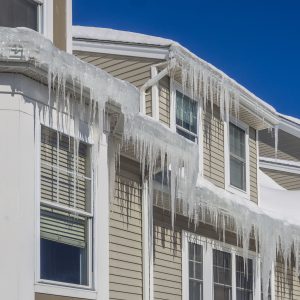 They might add a touch of that “winter wonderland” look to your home, but if you live in a snowy climate you should already know just how damaging ice dams can be. But chances are you’re clinging to many of the same myths most others are, and missing the real source of the problem.
They might add a touch of that “winter wonderland” look to your home, but if you live in a snowy climate you should already know just how damaging ice dams can be. But chances are you’re clinging to many of the same myths most others are, and missing the real source of the problem.
Ice dams are one of the more misunderstood building science challenges that plague houses during winter. Diagnosing the issue incorrectly can result in serious damage to the home, so lets take a quick look at the primary causes, biggest myths, and most effective prevention strategies.
With the right information, you’ll be in a situation to help your HVAC clients solve existing ice dam issues and prevent future ones.
What exactly are ice dams?
First things first, what is an ice dam and how is it caused? Typically, ice dams result in a large accumulation of ice and icicles hanging from the eaves and edges of a home’s roof.
They’re caused by uneven heat on a sloped roof. As snow begins to melt higher up the roof, the water runs down to the cooler sections below and begins to freeze, usually at the eaves. As time goes on, the ice builds and can create a dam, causing water to accumulate and ice to build.
This extra weight can cause significant damage to the roof, and often leads to serious leaks down into the ceilings and walls of the home.
How to prevent ice dams the wrong way
All of the wrong ways to prevent ice dams boil down to being band-aids that are best avoided. One of the most common is to shovel the snow away from the edge of the roof. In reality, this does nothing to prevent melt-water from freezing at the eaves.
Some also suggest shoveling the snow off your entire roof. This can help, to be sure, but if you’re in a climate that regularly receives enough snow for ice dams to be an issue, shoveling an entire roof is a dangerous and time-intensive solution.
Other band-aid solutions include installing heat cables in a zig-zag formation along the edge of the roof. Not only does this waste more energy in the home, it doesn’t entirely prevent ice build up at the edges of the roof. The ice it melts often simply refreezes in new formations and along the gutters.
How to prevent ice dams the right way
If a home is prone to ice dams, the underlying cause needs to be addressed: Excess heat is leaking from the living spaces into the attic. Most of the time, this is easily correctable.
Start by assessing the roof and soffit vents. Proper ventilation is essential for the longevity of the roof. Poor ventilation can cause several problems in an attic, including heat build-up during the winter months. Choosing the correct vents like one-piece soffit vents will keep the attic at a consistent temperature, which is the best way to prevent ice dams from forming.
You’ll also want to look for and seal up air leaks from the home into the attic, these are often found around light fixtures and electrical outlets. Another cause to look for? Rook leaks. These can cause warm air in the attic to escape, which will result in uneven temperatures in the attic — a prime cause of ice dams.



